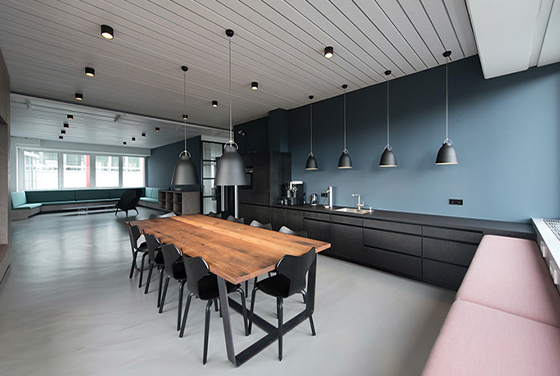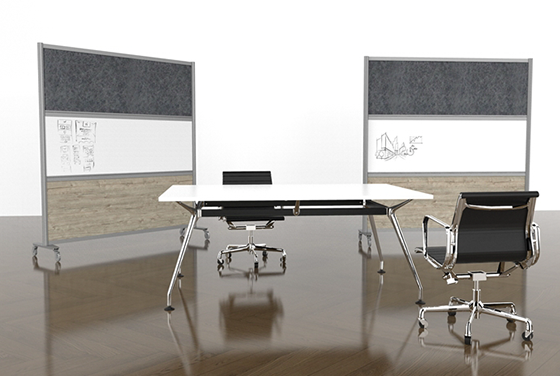Open office workspaces were designed primarily as a means to boost productivity, while fostering a sense of enthusiasm and teamwork. The premise was simple – to do away with stuffy cubicles and antique corporate ideas, while simultaneously embracing fresh new workplace trends designed to stimulate the minds of employees, and allow them to work better.
The response to the open office environment has been largely positive, but it has required some refinements over the years in order to combat the inherent challenges that come with such a layout. There are always ways to turn negatives into positives, even in an open office space. If your company is wondering whether to adopt this workspace model, you should read on and learn about the net benefits of open offices, and how to nip any potential problems in the bud.
OPEN OFFICES, DEFINED
Many workplace environments have lots of open space, but rather than maximize that potential, a lot of companies have sought to fill it up. In the past, this led to everything from poor foot traffic, to distractions, and a segmentation of employees that destroyed any sense of teamwork.
The push for open offices was to allow workspaces to breathe, and bring employees back into a central environment where they could bounce enthusiasm off of one another, while sharing ideas. The concept was a novel one, and was trademarked by neatly compartmentalized desks with no dividers, loungers and sofas, and open kitchen areas with a trendy atmosphere.
The advantages of open office workspaces are as follows:
TEAMWORK TO THE MAX
Open office spaces prevent employees from being wedged into claustrophobic cubicles all day long, which can severely hamper the enthusiasm of a company, not to mention make people feel disconnected from one another. Over time, this can make employees feel jaded and negative about the work environment, given that human beings are such social creatures.
Open offices have a knack for making employees interact more with one another, and that’s beneficial to formulating new ideas as it is for strengthening a sense of company culture and common purpose.
A GREATER WORKING RELATIONSHIP WITH MANAGEMENT
Open offices tend to favor a “no egos” approach, which means managers, and even bosses will take part in the layout whenever possible. By stripping everything down to teamwork, employees feel less like worker ants, and more like valued, contributing members of a company’s growth and success.
Managers who share the same open office space with employees tend to be looked upon more favorably as members of the team, as opposed to hard-nosed higher-ups who are out of touch with the daily routine. The more a team feels cohesive and united, the better the overall mood will be inside a workplace.
FLEXIBLE SPACE
Open offices tend to favor office furniture that isn’t bolted into place, and can be easily moved. That’s especially handy for companies that are growing at an accelerated rate, and need to reposition office furniture on the fly. As the pool of employees grows, so too will the need to reconfigure available desks and other office furniture, in order to accommodate them.
At the same time, open offices work hand-in-hand with contemporary business practices such as hot-desking, which involves multiple employees utilizing the same desk at different periods of the day or week. This is even more prevalent in an age when many employees are splitting their time between the home office, and the primary workplace. The open office space is essentially one gigantic slate that can be cleaned at a moment’s notice, and redeployed for maximum firepower whenever the situation calls for it.
COST-SAVINGS
It’s no secret that cubicles and other similar desking options are significantly more expensive than open-concept office desking and furniture alternatives. Not only that, but the latter will help with fostering a sense of teamwork. Cubicles have such a notorious reputation that it’s a fair bet they’ll never see a return, at least not in their past form.
Meanwhile, companies can save thousands of dollars by focusing on office furniture with a modular approach that can be custom-fitted to suit any floor plan. fluidconcepts prides itself at being at the very forefront of this philosophy, and all of our office furniture products are designed with this approach in mind.
DEALING WITH THE DISADVANTAGES
No office layout system is perfect, and open offices do have their fair share of drawbacks. Thankfully, many of these challenges can be alleviated with a few modifications to approach, as well as the correct choice of office furniture products.
The biggest drawback of an open office space is the lack of privacy, and that’s difficult for many employees who have more introverted personalities. Even many outgoing individuals have trouble focusing on their work with so many people moving about. The more open an office is, the more distractions can occur. The solution to this problem is to offer alternative areas for employees to do work that requires focus.
For instance, break rooms can serve a dual purpose – not just to provide employees a spot to relax on break, but also to drown out the bustle of the main workfloor. It’s also wise to invest in office furniture products that offer enclosure options. When employees need to hunker down and silence the noise, it’s best to provide them with an option like fluidconcepts’ own Orbit Pods, which are designed to eliminate this problem.
HEALTH-RELATED ISSUES
One of the main benefits of a traditional cubicle system was the reduction in transmissible viruses, which meant less employees taking off sick time for work. With an open office system, germs are free to float about, unabated by solid dividers. This became especially problematic during the Covid-19 pandemic, which forced many companies to adopt a remote work approach, rather than risk person-to-person transmission.
Moving forward, there are solutions to this problem as well. Many of the desking options that fluidconcepts offers allow for dividers to be installed in order to section off employees, all without losing that feeling of team cohesion. It’s important that employees still be able to interact, even when one (or several) of them have the sniffles.
TOO MANY PEOPLE
With open office layouts, there’s a temptation to stuff as many employees into the space as possible, and that’s when the law of diminishing returns starts to kick in. Employers should be wary of constructing their open office space in such a way that the distractions and noise become too much to ignore.
Studies have shown that when this happens, employees feel less sanguine about their jobs, and that can lead to negativity and decreased career satisfaction. Once again, having alternative areas for employees to migrate to can help offset this problem. A lot of today’s work is laptop and tablet-based, which means employees aren’t tethered to a desktop workstation any longer. If they need some time to get away from it all, they can simply grab their work device, and find a cozy (and quiet) corner somewhere else.
CONCLUSION
Despite some of the negative press surrounding open office layouts, they can work in your company’s favor. All it takes is some forethought and planning, as well as listening to your employees, and providing them with the best office furniture to compliment such a workspace.
Call fluidconcepts today to discuss office furniture options for your open office space layout.





